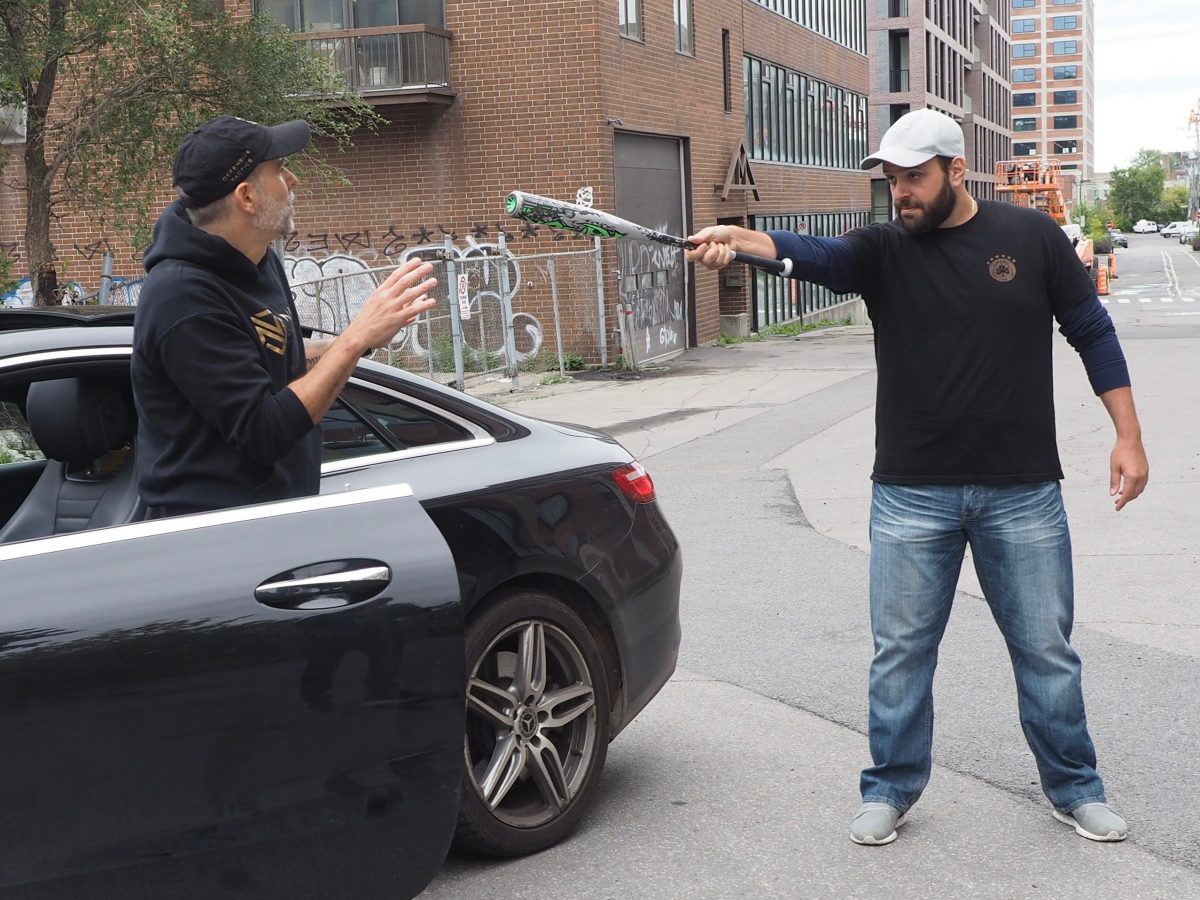Road rage is a universal term to describe the explosive anger we humans experience, especially when we’re behind the wheel. In 2021, 44 people per month were shot and killed or wounded in road rage shootings – double the pre-pandemic average. So it’s not extraordinary to hear reports of furious drivers confronting and beating innocent people with crowbars, baseball bats, or worse.
According to one Harvard study, hostile actions are most common among men, young adults, and individuals carrying firearms in their vehicles. Road rage is executed in a retaliatory form when the aggressor feels wronged and consequently takes revenge on their perceived wrong-doer. It’s a driver-blamed criminal offense.
Immediate access to Krav Maga Weapon Defense training!
Classic road rage:
- Tailgating
- Yelling
- Angry and excessive honking
- Hostile gestures
- Blocking a lane change
- Intentionally cutting off a vehicle
- Intentionally bumping or crashing into another vehicle
- Exiting your vehicle to confront another driver

Did you know?
51% tailgate intentionally (104 million American drivers)
47% yell at other drivers (95 million American drivers)
45% honk in anger or annoyance (91 million American drivers)
33% gesture obscenely (67 million American drivers)
(Based on a CNN Health Poll)
Road rage is further defined as an instance of criminal or violent behavior that spawns from a traffic altercation intending to harm other drivers. Threats are massive triggers in disturbing road rage behavior and propel the fight or flight response in vexed drivers. The rage produces an immediate and intense emotional reaction, so unexpected moves, like braking or changing lanes at the last moment, could prove disastrous for you.
Aggressive driving occurs on a spectrum – on the lower end are calm drivers, with typical frustrations, and the upper end capping extremely hostile drivers, who experience road rage often. For some, there is also a biological and cognitive science behind their violent outbursts. Unfortunately, despite hard core training and efforts to diffuse the situation, there may be no taming the beast.
Even if your intention is not to harm or intimidate any driver or pedestrian, anyone experiencing road rage believes otherwise. It’s a dangerous mindset to assume the worst about you, but it’s the crux of all anger and violence on the road.
Arming yourself with road-rage survival tips should be par for the course for every driver. So, the purpose of this year’s very first blog is to help you navigate potential road violence. The insight focuses on the wrath of being a victim and simultaneously causes us to identify how we possibly influence road rage.

FACT: 30 murders are linked to road rage annually (American Psychology Association)
TIP 1: Curb your own rage
Road rage includes speeding, tailgating, cutting drivers off, and making obscene gestures. Punitory or not – these actions could create a deadly scenario if they provoke aggression in another driver – the wrong driver.
There will always be a small percentage of people on the brink of losing control at any second. A ticking time bomb behind the wheel, walking across the street, or even parked in their vehicle – so keeping your cool is paramount.
Before hitting the road, it’s vital to be mentally prepared, giving yourself ample time to reach your destination. You’re more inclined to become impatient and take risks if you’re panicking to get from point A to point B in record time.
Ensuring you have a clear head when driving can be life-saving, so entering your vehicle with a calm mindset is pivotal. Driving upset or heated can only exasperate a volatile situation.
TIP 2: Practice defensive driving
You could be sharing the road with someone in a hurry, having a bad day, or even under the influence of drugs or alcohol, making them more susceptible to reactive behavior. Being attentive to your driving and respectful of other drivers and pedestrians could be a changer. A single event does not often trigger road rage, so cutting someone off (even by accident) or refusing to let someone in could induce a quick, downward spiral for someone already revved up.
TIP 3: Forget and eye for an eye
Aggressive, retaliatory actions like excessively honking your horn is never advantageous. The often instinctual reaction is a surefire way to propel road rage and accidents. A Krav Maga mindset practices being pre-emptive rather than reactive. So, although tempting and often spontaneous, if someone tailgates, cuts you off, or hurls insults or obscenities, etc., the safest route is to stay in your lane – so to speak. Recoiling with equally destructive impulses like slamming on your brakes could be hazardous.
FACT: 50% of drivers respond to the careless acts of other drivers with aggressive behaviour themselves (American Psychology Association)
TIP 4: Stay in your locked vehicle
A triggered driver may become verbally and physically violent and too gripped with fury to let any ‘slights’ go. In this scenario, remaining in your vehicle with windows up and doors locked is essential to creating a barrier or separation between you and your aggressor.
As I discuss in ‘How to Defend and Survive a Carjacking’, drawing attention to yourself could be fundamental to your survival. Activating your car alarm, honking your horn, and flashing your lights are critical ways of alerting people around you that you are in danger and require assistance. It’s ideal to drive away as quickly as possible, find a crowded area or police station and call for help. Unless you’re forcibly dragged out of your vehicle – always remain in your vehicle.
TIP 5: Avoid eye contact
A win-win situation would be to keep your gaze away from your aggressor and avoid a stare down. And no, it’s not a sign of weakness. To an agitated, irrational driver, it’s a sign of mutual anger, so keeping your eyes front and the center should be your focus.
Eye contact is a form of engagement, which is something to guard against on the road – within limits. You can casually glance over, being detached and composed, and remain alert to what’s happening in your peripherals.
It’s critical to continue to practice situational awareness – without provocation. Like in the animal kingdom, it could be conveyed as a threat. Although your glance may not be challenging, it may be to a driver possessing a gun or improvised weapon under their seat.
TIP 6: Outside of the vehicle
If you’ve willingly exited your vehicle after a fender bender, you’re automatically at a severe disadvantage. Being face-to-face with a possible aggressor can end in injury or death. A simple exchange of information or a disagreement about who may be at fault can quickly escalate into a violent assault. At this point, you must do everything you can to escape alive. Learn how to target vulnerable zones – here!

FACT: 37% of aggressive driving incidents involve a firearm (AutoVantage Club)
TIP 7: When push comes to shove
In a worst-case scenario, active defense is not only logical but imperative. Ultimately it’s the green light for proceeding with force because you’ve run out of all other options. Using your intuition and Krav Maga training is best to determine whether your life is at risk – enough to warrant taking out a weapon or firearm. Your safety always begins with solid awareness training and split-second decision-making.

The Outro:
The psychology of road rage keeps this topic interesting and, at the same time – critical. The aggressive driver is not always a combative person off-road. It’s also people like you or I who may have gotten distracted or made an honest mistake when driving. We have hectic days and sleepless nights. We lose our jobs and our homes. We fight with friends and family. And still, we get behind the wheel – and so do they. Will you be prepared for anything?
Road violence can end up deadly. Learn how to defend against road rage!
Master the power of weapon defense!

Teaching prevention, detection, and ultimately setting up for the initial strike to be one step ahead of the attacker, will always be in hardcore demand. My training options are diverse, custom, and trusted. They are dynamic systems indicative of real-world self-defense to sustain personal protection. Which one will empower you?


